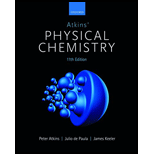
Concept explainers
(i)
Interpretation:
The de-Broglie wavelength of a mass of 1.0 g travelling at a speed of 1 cm s−1 has to be calculated.
Concept introduction:
De-Broglie’s hypothesis suggested the wave like nature of particles. Any particle which has a linear momentum must also have a characteristic wavelength corresponding to that momentum.
(ii)
Interpretation:
The de-Broglie wavelength of a mass of 1.0 g travelling at a speed of 100 km s−1 has to be calculated.
Concept introduction:
De-Broglie’s hypothesis suggested the wave like nature of particles. Any particle which has a linear momentum must also have a characteristic wavelength corresponding to that momentum..
(iii)
Interpretation:
The de-Broglie wavelength of a He atom travelling at a speed of 1000 m s−1 has to be calculated.
Concept introduction:
De-Broglie’s hypothesis suggested the wave like nature of particles. Any particle which has a linear momentum must also have a characteristic wavelength corresponding to that momentum..
Want to see the full answer?
Check out a sample textbook solution
Chapter 7 Solutions
Atkins' Physical Chemistry
- Don't used hand raiting and don't used Ai solutionarrow_forwardH2(g) + I2(g) ⇔ 2HI(g) Using the above equilibrium, find the equilibrium concentration of H2 if the intial concentration of both H2 and I2 are 2.0. K at this temperature is 55.64.arrow_forwardfind K, the equilibrium constant, if the inital concentration of SO3 is 0.166 M, and the equilibrium concentration of O2 is 0.075 M. 2SO3 (g) ⇌ 2SO2 (g) + O2 (g)arrow_forward
- Q4: Rank the relative nucleophilicity of halide ions in water solution and DMF solution, respectively. F CI Br | Q5: Determine which of the substrates will and will not react with NaSCH3 in an SN2 reaction to have a reasonable yield of product. NH2 Br Br Br OH Brarrow_forwardQ7: Rank the following groups in order of basicity, nucleophilicity, and leaving group ability. a) H₂O, OH, CH3COOT b) NH3, H₂O, H₂Sarrow_forwardQ8: Rank the following compounds in order of increasing reactivity in a nucleophilic substitution reaction with CN as the nucleophile. Br A B NH2 LL F C D OH CI LLI E Q9: Complete the missing entities for following reactions (e.g., major product(s), reactants, and/or solvents) for the SN2 reactions to occur efficiently. Include curved-arrow mechanism for reactions a) to d). a) H "Cl D + -OCH 3 Page 3 of 5arrow_forward
- Q10: (a) Propose a synthesis of C from A. (b) Propose a synthesis of C from B. Br Br ...\SCH 3 A B Carrow_forward9: Complete the missing entities for following reactions (e.g., major product(s), reactants, and/or solvents) for the SN2 reactions to occur efficiently. Include curved-arrow mechanism for reactions a) to d).arrow_forwardComplete the missing entities for following reactions (e.g., major product(s), reactants, and/or solvents) for the SN2 reactions to occur efficiently. Include curved-arrow mechanism for reactions a) to d).arrow_forward
- QUESTION 3: Provide the synthetic steps that convert the starting material into the product (no mechanism required). HO OH NH CH3 multiple steps 요요 H3Carrow_forwardQ6: Predict the effect of the changes given on the rate of the reaction below. CH3OH CH3Cl + NaOCH3 → CH3OCH3 + NaCl a) Change the substrate from CH3CI to CH31: b) Change the nucleophile from NaOCH 3 to NaSCH3: c) Change the substrate from CH3CI to (CH3)2CHCI: d) Change the solvent from CH3OH to DMSO.arrow_forwardQ3: Arrange each group of compounds from fastest SN2 reaction rate to slowest SN2 reaction rate. a) CI Cl فيكم H3C-Cl A B C D Br Br b) A B C Br H3C-Br Darrow_forward
 ChemistryChemistryISBN:9781305957404Author:Steven S. Zumdahl, Susan A. Zumdahl, Donald J. DeCostePublisher:Cengage Learning
ChemistryChemistryISBN:9781305957404Author:Steven S. Zumdahl, Susan A. Zumdahl, Donald J. DeCostePublisher:Cengage Learning ChemistryChemistryISBN:9781259911156Author:Raymond Chang Dr., Jason Overby ProfessorPublisher:McGraw-Hill Education
ChemistryChemistryISBN:9781259911156Author:Raymond Chang Dr., Jason Overby ProfessorPublisher:McGraw-Hill Education Principles of Instrumental AnalysisChemistryISBN:9781305577213Author:Douglas A. Skoog, F. James Holler, Stanley R. CrouchPublisher:Cengage Learning
Principles of Instrumental AnalysisChemistryISBN:9781305577213Author:Douglas A. Skoog, F. James Holler, Stanley R. CrouchPublisher:Cengage Learning Organic ChemistryChemistryISBN:9780078021558Author:Janice Gorzynski Smith Dr.Publisher:McGraw-Hill Education
Organic ChemistryChemistryISBN:9780078021558Author:Janice Gorzynski Smith Dr.Publisher:McGraw-Hill Education Chemistry: Principles and ReactionsChemistryISBN:9781305079373Author:William L. Masterton, Cecile N. HurleyPublisher:Cengage Learning
Chemistry: Principles and ReactionsChemistryISBN:9781305079373Author:William L. Masterton, Cecile N. HurleyPublisher:Cengage Learning Elementary Principles of Chemical Processes, Bind...ChemistryISBN:9781118431221Author:Richard M. Felder, Ronald W. Rousseau, Lisa G. BullardPublisher:WILEY
Elementary Principles of Chemical Processes, Bind...ChemistryISBN:9781118431221Author:Richard M. Felder, Ronald W. Rousseau, Lisa G. BullardPublisher:WILEY





